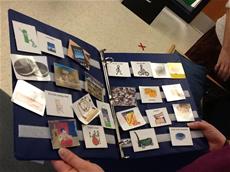Microsoft in Education Global Forum, Dubai, 2...
0 comments
 14
14  We have had the opportunity to visit many Special Education Early Childhood classrooms (ECSE)and talk to many teachers in our district. Assistive technology (AT) plays an essential role for student participation and success. The Center for Applied Special Technology (CAST) provides many toolkits for educators (visit http://www.cast.org/teachingeverystudent/toolkits/ ). Although many classrooms have individual students that need specific assistive technologies written in their IEP that ensures their individual success wouldn’t it be proactive to take a universal design for learning approach and have an AT toolbox that could be implemented into daily activities (playing, communicating, exploring the environment, etc.) for any student that could benefit! Preliminary research has been conducted by Judge (2006) asking early childhood special education practitioners what devices they thought should be included in such a toolkit. The results of this study identified a preliminary AT toolkit that supports young children’s participation in daily activities that involve communication, movement, and interaction with materials. Tools that were identified in this study included items such as picture communication symbols, visual schedules, talking switches, adapted scissor, adapted tables and chairs, bean bag chairs, switch accessible toys and games, talking books, touch screen for computer access to name just a few.
We have had the opportunity to visit many Special Education Early Childhood classrooms (ECSE)and talk to many teachers in our district. Assistive technology (AT) plays an essential role for student participation and success. The Center for Applied Special Technology (CAST) provides many toolkits for educators (visit http://www.cast.org/teachingeverystudent/toolkits/ ). Although many classrooms have individual students that need specific assistive technologies written in their IEP that ensures their individual success wouldn’t it be proactive to take a universal design for learning approach and have an AT toolbox that could be implemented into daily activities (playing, communicating, exploring the environment, etc.) for any student that could benefit! Preliminary research has been conducted by Judge (2006) asking early childhood special education practitioners what devices they thought should be included in such a toolkit. The results of this study identified a preliminary AT toolkit that supports young children’s participation in daily activities that involve communication, movement, and interaction with materials. Tools that were identified in this study included items such as picture communication symbols, visual schedules, talking switches, adapted scissor, adapted tables and chairs, bean bag chairs, switch accessible toys and games, talking books, touch screen for computer access to name just a few.
A critical concept of AT is to continuously support the child’s development by providing tools that address the challenges that may limit his or her ability to play with toys, communicate, participate, and explore the environment. Many AT tools that children use to participate in daily activities can be found commercially or adjusted for use with minor adaptations (Judge, Floyd, Jeffs , 2008). 
So what's in your AT toolbox? Let’s brainstorm a few of our favorite AT tools:


Speech generating devices also known as voice-output communication aids allow messages to be recorded and provide a means for children to communicate, express ideas, and participate in daily routines, learning activities, and social situations. These devices could be used for just a single message at a time (simple output devices ) or multiple messages (multi-cell,multi-level communication devices). Communications notebooks and Talking Photo Albums also provide a wonderful low-cost pathway to providing opportunities for conversation.
From adapted crayons to slant boards there are many wonderful ways to modify or adapt writing tools that enable young learners to be a participant in the writing process. Here is a great blog that shows 10 easy ways to make adaptations that could help children write. (http://www.lovethatmax.com/2013/02/helping-kids-with-disabilities-write.html). Work closely with your Occupational Therapist ( OT)for ideas and resources. For example here is a step by step description of making an adapted holder (http://abbypediatricot.blogspot.com/2012/02/how-to-make-adapted-crayon.html)
Here is a nice Pinterest collection of tactile symboll ideas http://www.pinterest.com/cmcormier/aac-tangible-symbols/


http://www.filefolderfun.com/FileFolderGames.html


Computer access can be difficult for some children. A single click mouse can eliminate the accidental right click menus that seem to pop up and interfere into the task at hand. If you don't have a single click mouse adaptations can be made to a standard computer mouse. A mouse house can turn a standard mouse into a switch. Other computer access solutions include different types of switches that can be activated with a switch interface, adapted mice and touch screens.
Doesn’t it just make sense to equip Early Childhood Special Education Classrooms with an assortment of AT tools thus affords opportunities for a seamless approach to technology integration? With that question in mind what AT tools would you include? Do you have your own classroom AT toolbox? Take a minute and share your ideas with others here on the blog!
Judge, S., Floyd, K., & Jeffs, T. (2008). Using an assistive technology toolkit to promote inclusion. Early Childhood Education Journal, 36, 121-126.
Judge, S. (2006). Constructing an assistive technology toolkit for young children: Views from the field. Journal of Special Education Technology, 21(4), 17–24.
http://bit.ly/NCATPResources
http://www.wonderbaby.org/articles/apps-for-children-who-are-visually-impaired
Tots –‘n- Tech http://tnt.asu.edu/ Great AT research briefs, practice ideas, and make it use it ideas
http://www.pinterest.com/katielyn27/early-childhood-special-education/
http://bit.ly/ECSETools